Page 296 of 360
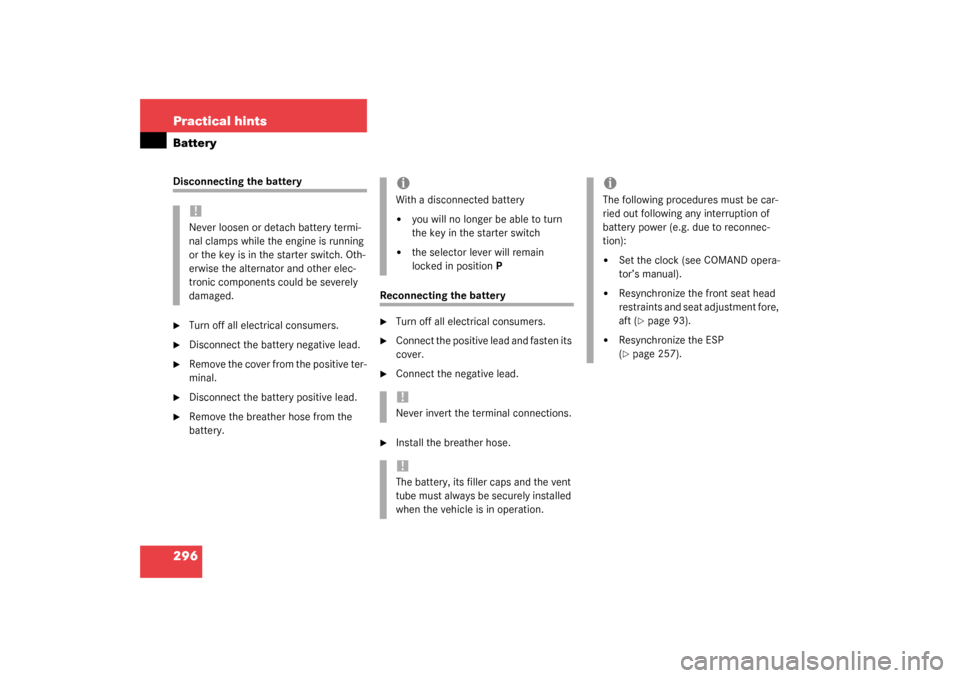
296 Practical hintsBatteryDisconnecting the battery�
Turn off all electrical consumers.
�
Disconnect the battery negative lead.
�
Remove the cover from the positive ter-
minal.
�
Disconnect the battery positive lead.
�
Remove the breather hose from the
battery.
Reconnecting the battery�
Turn off all electrical consumers.
�
Connect the positive lead and fasten its
cover.
�
Connect the negative lead.
�
Install the breather hose.
!Never loosen or detach battery termi-
nal clamps while the engine is running
or the key is in the starter switch. Oth-
erwise the alternator and other elec-
tronic components could be severely
damaged.
iWith a disconnected battery�
you will no longer be able to turn
the key in the starter switch
�
the selector lever will remain
locked in positionP
!Never invert the terminal connections.!The battery, its filler caps and the vent
tube must always be securely installed
when the vehicle is in operation.
iThe following procedures must be car-
ried out following any interruption of
battery power (e.g. due to reconnec-
tion):�
Set the clock (see COMAND opera-
tor’s manual).
�
Resynchronize the front seat head
restraints and seat adjustment fore,
aft (
�page 93).
�
Resynchronize the ESP
(�page 257).
Page 297 of 360
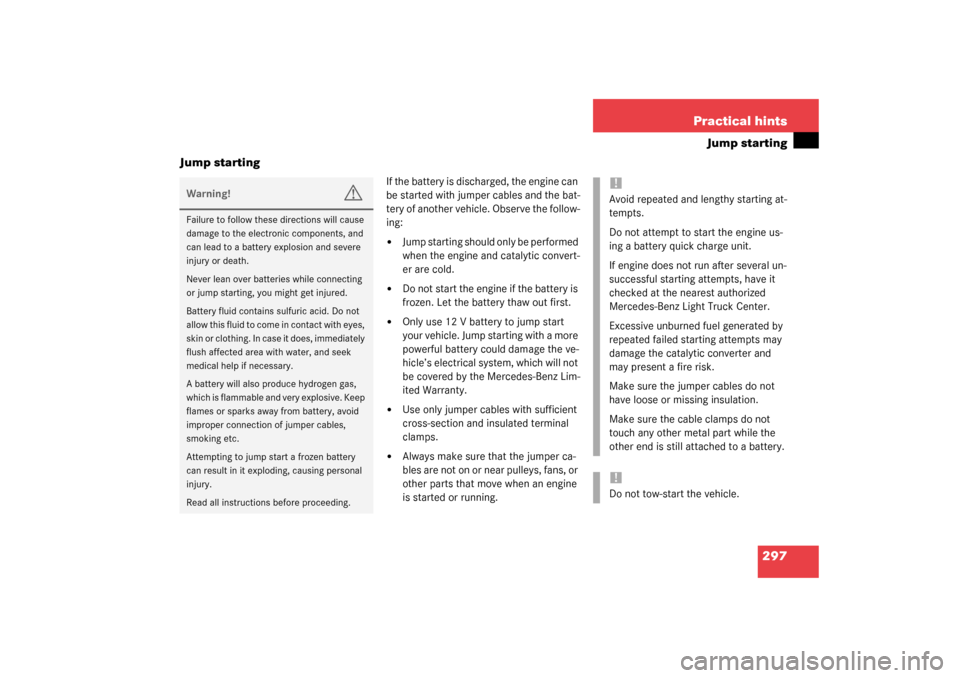
297 Practical hints
Jump starting
Jump starting
If the battery is discharged, the engine can
be started with jumper cables and the bat-
tery of another vehicle. Observe the follow-
ing:�
Jump starting should only be performed
when the engine and catalytic convert-
er are cold.
�
Do not start the engine if the battery is
frozen. Let the battery thaw out first.
�
Only use 12 V battery to jump start
your vehicle. Jump starting with a more
powerful battery could damage the ve-
hicle’s electrical system, which will not
be covered by the Mercedes-Benz Lim-
ited Warranty.
�
Use only jumper cables with sufficient
cross-section and insulated terminal
clamps.
�
Always make sure that the jumper ca-
bles are not on or near pulleys, fans, or
other parts that move when an engine
is started or running.
Warning!
G
Failure to follow these directions will cause
damage to the electronic components, and
can lead to a battery explosion and severe
injury or death.
Never lean over batteries while connecting
or jump starting, you might get injured.
Battery fluid contains sulfuric acid. Do not
allow this fluid to come in contact with eyes,
skin or clothing. In case it does, immediately
flush affected area with water, and seek
medical help if necessary.
A battery will also produce hydrogen gas,
which is flammable and very explosive. Keep
flames or sparks away from battery, avoid
improper connection of jumper cables,
smoking etc.
Attempting to jump start a frozen battery
can result in it exploding, causing personal
injury.
Read all instructions before proceeding.
!Avoid repeated and lengthy starting at-
tempts.
Do not attempt to start the engine us-
ing a battery quick charge unit.
If engine does not run after several un-
successful starting attempts, have it
checked at the nearest authorized
Mercedes-Benz Light Truck Center.
Excessive unburned fuel generated by
repeated failed starting attempts may
damage the catalytic converter and
may present a fire risk.
Make sure the jumper cables do not
have loose or missing insulation.
Make sure the cable clamps do not
touch any other metal part while the
other end is still attached to a battery.!Do not tow-start the vehicle.
Page 298 of 360
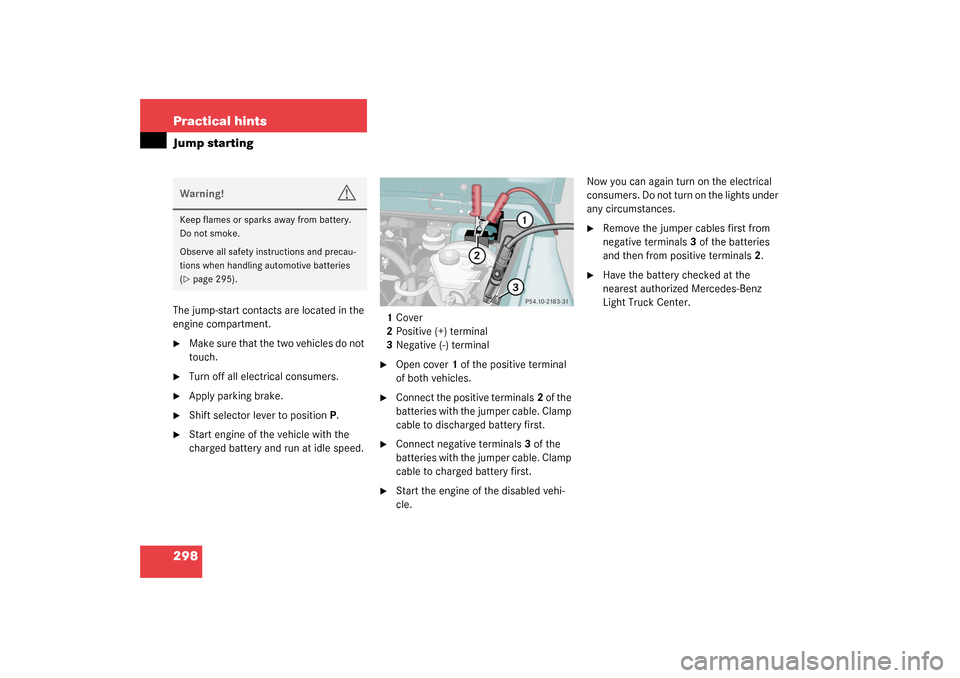
298 Practical hintsJump startingThe jump-start contacts are located in the
engine compartment.�
Make sure that the two vehicles do not
touch.
�
Turn off all electrical consumers.
�
Apply parking brake.
�
Shift selector lever to positionP.
�
Start engine of the vehicle with the
charged battery and run at idle speed.1Cover
2Positive (+) terminal
3Negative (-) terminal
�
Open cover1 of the positive terminal
of both vehicles.
�
Connect the positive terminals2 of the
batteries with the jumper cable. Clamp
cable to discharged battery first.
�
Connect negative terminals3 of the
batteries with the jumper cable. Clamp
cable to charged battery first.
�
Start the engine of the disabled vehi-
cle.Now you can again turn on the electrical
consumers. Do not turn on the lights under
any circumstances.
�
Remove the jumper cables first from
negative terminals3 of the batteries
and then from positive terminals2.
�
Have the battery checked at the
nearest authorized Mercedes-Benz
Light Truck Center.
Warning!
G
Keep flames or sparks away from battery.
Do not smoke.
Observe all safety instructions and precau-
tions when handling automotive batteries
(�page 295).
Page 299 of 360
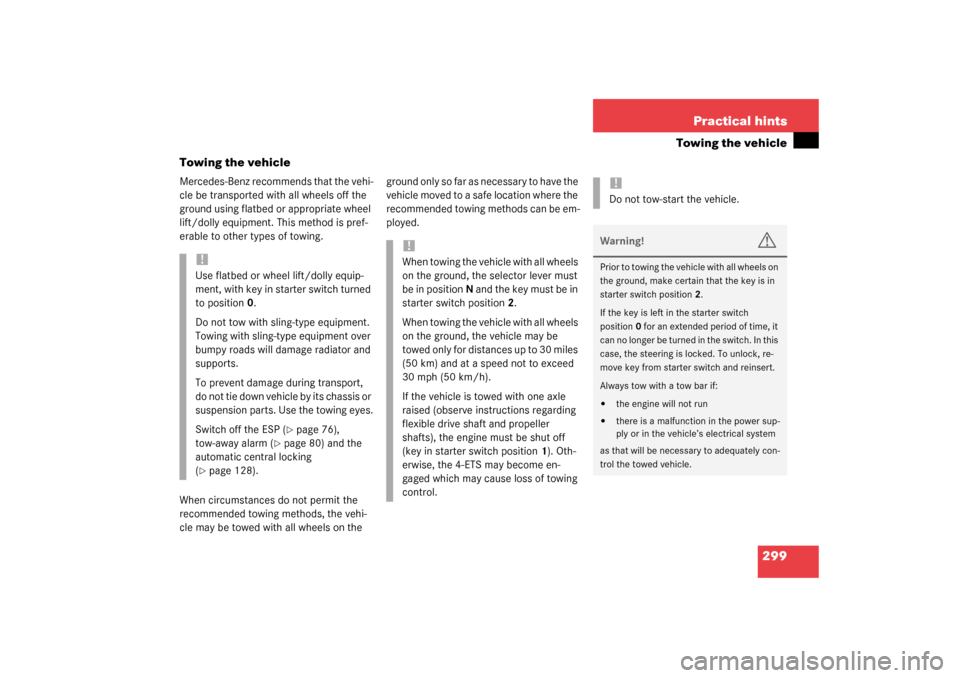
299 Practical hints
Towing the vehicle
Towing the vehicle
Mercedes-Benz recommends that the vehi-
cle be transported with all wheels off the
ground using flatbed or appropriate wheel
lift/dolly equipment. This method is pref-
erable to other types of towing.
When circumstances do not permit the
recommended towing methods, the vehi-
cle may be towed with all wheels on the ground only so far as necessary to have the
vehicle moved to a safe location where the
recommended towing methods can be em-
ployed.
!Use flatbed or wheel lift/dolly equip-
ment, with key in starter switch turned
to position0.
Do not tow with sling-type equipment.
Towing with sling-type equipment over
bumpy roads will damage radiator and
supports.
To prevent damage during transport,
do not tie down vehicle by its chassis or
suspension parts. Use the towing eyes.
Switch off the ESP (
�page 76),
tow-away alarm (
�page 80) and the
automatic central locking
(
�page 128).
!When towing the vehicle with all wheels
on the ground, the selector lever must
be in position N and the key m us t be in
starter switch position 2.
When towing the vehicle with all wheels
on the ground, the vehicle may be
towed only for distances up to 30 miles
(50 km) and at a speed not to exceed
30 mph (50 km/h).
If the vehicle is towed with one axle
raised (observe instructions regarding
flexible drive shaft and propeller
shafts), the engine must be shut off
(key in starter switch position1). Oth-
erwise, the 4-ETS may become en-
gaged which may cause loss of towing
control.
!Do not tow-start the vehicle.Warning!
G
Prior to towing the vehicle with all wheels on
the ground, make certain that the key is in
starter switch position2.
If the key is left in the starter switch
position0 for an extended period of time, it
can no longer be turned in the switch. In this
case, the steering is locked. To unlock, re-
move key from starter switch and reinsert.
Always tow with a tow bar if:�
the engine will not run
�
there is a malfunction in the power sup-
ply or in the vehicle’s electrical system
as that will be necessary to adequately con-
trol the towed vehicle.
Page 300 of 360
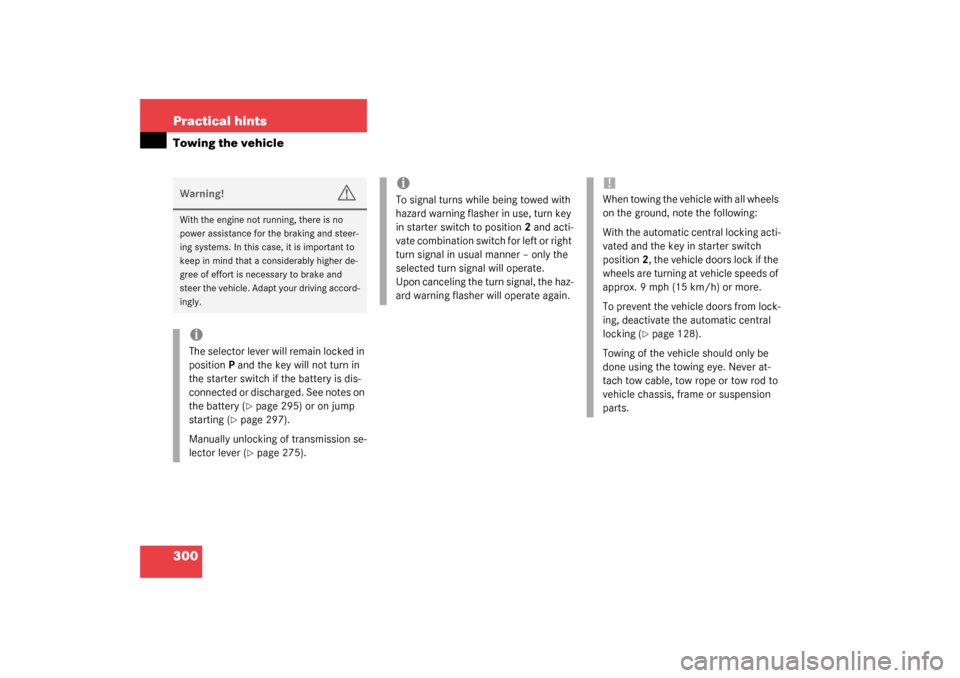
300 Practical hintsTowing the vehicleWarning!
G
With the engine not running, there is no
power assistance for the braking and steer-
ing systems. In this case, it is important to
keep in mind that a considerably higher de-
gree of effort is necessary to brake and
steer the vehicle. Adapt your driving accord-
ingly.iThe selector lever will remain locked in
positionP and the key will not turn in
the starter switch if the battery is dis-
connected or discharged. See notes on
the battery (
�page 295) or on jump
starting (
�page 297).
Manually unlocking of transmission se-
lector lever (�page 275).
iTo signal turns while being towed with
hazard warning flasher in use, turn key
in starter switch to position2 and acti-
vate combination switch for left or right
turn signal in usual manner – only the
selected turn signal will operate.
Upon canceling the turn signal, the haz-
ard warning flasher will operate again.
!When towing the vehicle with all wheels
on the ground, note the following:
With the automatic central locking acti-
vated and the key in starter switch
position2, the vehicle doors lock if the
wheels are turning at vehicle speeds of
approx. 9 mph (15 km/h) or more.
To prevent the vehicle doors from lock-
ing, deactivate the automatic central
locking (
�page 128).
Towing of the vehicle should only be
done using the towing eye. Never at-
tach tow cable, tow rope or tow rod to
vehicle chassis, frame or suspension
parts.
Page 307 of 360
307 Technical data
Spare parts service
Warranty coverage
Identification labels
Layout of poly-V-belt drive
Engine
Rims and tires
Electrical system
Main dimensions, vehicle weights and ratings
Fuels, coolants, lubricants etc.
Consumer information
Page 310 of 360
310 Technical dataIdentification labels
Identification labels1Certification label and Paintwork Num-
ber2Vehicle Identification Number (VIN)
(lower edge of windshield)
3Engine number (engraved on engine)
4Information label, California version
5Emission control label
Vacuum line routing for emission con-
trol systemWhen ordering spare parts, please specify
vehicle identification and engine numbers.
Page 312 of 360
312 Technical dataEngine
Engine
G 500 (463.249
1)
1The quoted data apply only to the standard vehicle. See an authorized Mercedes-Benz Light Truck Center for the corresponding data of all special bodies and special
equipment.
G55AMG (463.246
1)
Engine
113
113
Mode of operation
4-stroke engine, gasoline injection
4-stroke engine, gasoline injection
No. of cylinders
8
8
Bore
3.82 in (97.00 mm)
3.82 in (97.00 mm)
Stroke
3.31 in (84.00 mm)
3.60 in (92.00 mm)
Total piston displacement
303.0 cu.in. (4966 cm
3)
331.8 cu.in. (5439 cm
3)
Compression ratio
10:1
10.5:1
Output acc. to SAE J 1349
292 hp / 5500 rpm
(218 kW / 5500 rpm)
349 hp / 5500 rpm
(260 kW / 5500 rpm)
Maximum torque acc. to SAE J 1349
336ft.lb/2800rpm
(454 Nm / 2800 rpm)
387ft.lb/2600rpm
(525 Nm / 2600 rpm)
Maximum engine speed
6000 rpm
6000 rpm
Firing order
1-5-4-2-6-3-7-8
1-5-4-2-6-3-7-8
Poly-V-belt
7ft 10in (2390mm)
7ft 10in (2390mm)